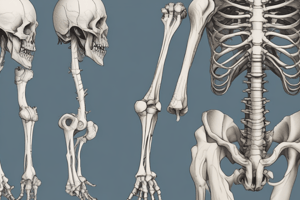Podcast
Questions and Answers
What is the longest and strongest bone in the human body?
What is the longest and strongest bone in the human body?
- Humerus
- Clavicle
- Femur (correct)
- Tibia
The hyoid bone is connected to other bones in the body.
The hyoid bone is connected to other bones in the body.
False (B)
How many bones does an adult human body have?
How many bones does an adult human body have?
206
The process of bone formation is known as _______.
The process of bone formation is known as _______.
Match the following types of bones with their characteristics:
Match the following types of bones with their characteristics:
What is the most commonly broken bone among children?
What is the most commonly broken bone among children?
Gastrulation occurs during the first week of human development.
Gastrulation occurs during the first week of human development.
What are the two types of cells produced by bones?
What are the two types of cells produced by bones?
Flashcards are hidden until you start studying
Study Notes
Bone Structure and Facts
- The human skeleton has 206 bones in adults and 350 bones in children.
- The femur is the longest and strongest bone, while the stapes (stirrup) in the middle ear is the smallest and lightest.
- The human foot has 26 bones, while the hand, including the wrist, has 54.
- Bones stop growing in length during puberty.
- The hyoid bone, located at the base of the tongue, is the only bone not connected to another.
- Bones are made up of minerals like calcium and phosphorus, as well as the protein collagen.
Bone Functions
- Bones provide structure and support, allow movement, and protect organs.
- They also produce red and white blood cells.
Formation and Types of Bones
- Ossification (osteogenesis) is the process of bone formation, starting between the sixth and seventh weeks of embryonic life.
- Germ layers, formed during gastrulation in the third week of human development, contribute to skeletal formation.
- The mesoderm germ layer develops into the skeletal system.
- Bones are classified into four types:
- Long bones: Long and thin (e.g., arms and legs)
- Short bones: Squat and cubed (e.g., wrist and ankle bones)
- Flat bones: Flattened and broad (e.g., skull, chest, and hip)
- Irregular bones: Peculiar shapes not conforming to the other types
Connective Tissue
- Tendon: Connects muscle to bone.
- Ligament: Tough fibrous band connecting bones together.
- Joint: Where two or more bones meet.
Numbers in the Body
- The human body has approximately 350 joints, 900 ligaments, and 4,000 tendons.
Studying That Suits You
Use AI to generate personalized quizzes and flashcards to suit your learning preferences.




